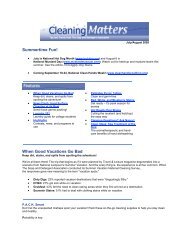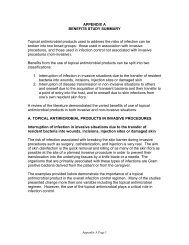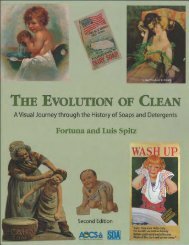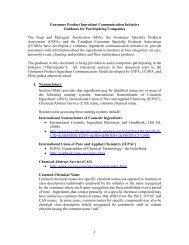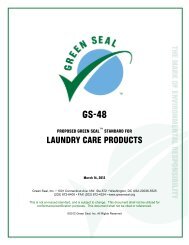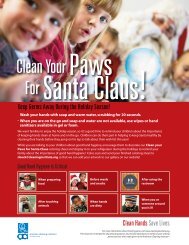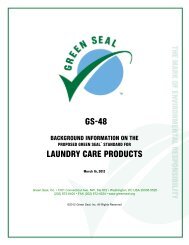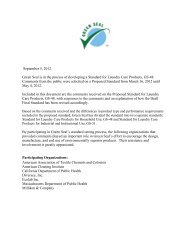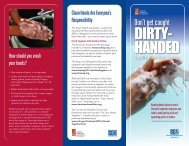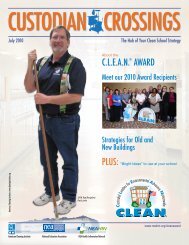subchapter c -- federal hazardous substances act regulations
subchapter c -- federal hazardous substances act regulations
subchapter c -- federal hazardous substances act regulations
Create successful ePaper yourself
Turn your PDF publications into a flip-book with our unique Google optimized e-Paper software.
(iii) Since the Commission has issued<br />
comprehensive <strong>regulations</strong> for lead containing<br />
paint and certain consumer products bearing<br />
such paint at the 0.06 percent level under the<br />
Consumer Product Safety Act (see 16 CFR<br />
part 1303), paragraphs (i) and (ii) of §<br />
1500.17(a)(6) are revoked as to the subject<br />
products manuf<strong>act</strong>ured after February 27,<br />
1978.<br />
NOTE: The effective date of paragraphs (a)(6)(i)(A) and<br />
(a)(6)(ii)(A) was stayed by an order published in the<br />
FEDERAL REGISTER of August 10, 1972 (37 FR<br />
16078).<br />
(7) General-use garments containing<br />
asbestos (other than garments having a bona<br />
fide application for personal protection against<br />
thermal injury and so constructed that the<br />
asbestos fibers will not become airborne under<br />
reasonably foreseeable conditions of use).<br />
(8) Firecrackers designed to produce<br />
audible effects, if the audible effect is<br />
produced by a charge of more than 50<br />
milligrams (.772 grains) of pyrotechnic<br />
composition (not including firecrackers<br />
included as components of a rocket), aerial<br />
bombs, and devices that may be confused with<br />
candy or other foods, such as “dragon eggs,”<br />
and “cracker balls” (also known as “balltype<br />
caps”), and including kits and components<br />
intended to produce such fireworks except<br />
such devices which meet all of the following<br />
conditions:<br />
(i) The fireworks devices are distributed to<br />
farmers, ranchers, or growers through a<br />
wildlife management program administered by<br />
the U.S. Department of Interior (or by<br />
equivalent State or local governmental<br />
agencies); and<br />
(ii) Such distribution is in response to a<br />
written application describing the wildlife<br />
management problem that requires use of such<br />
devices, is of a quantity no greater than<br />
required to control the problem described, and<br />
is where other means of control is unavailable<br />
or inadequate. (See also § 1500.17(a) (3) and<br />
(9)).<br />
(9) All fireworks devices, other than<br />
firecrackers, including kits and components<br />
intended to produce such fireworks, not<br />
otherwise banned under the <strong>act</strong>, that do not<br />
comply with the applicable requirements of<br />
part 1507 of this chapter, except fireworks<br />
16 CFR Ch. II (1–1–05 Edition)—proposed modificication – 6/25/06<br />
-- 23 --<br />
devices which meet all the following<br />
conditions:<br />
(i) The fireworks devices are distributed to<br />
farmers, ranchers, or growers through a<br />
wildlife management program administered by<br />
the U.S. Department of the Interior (or by<br />
equivalent State or local government<br />
agencies); and<br />
(ii) Such distribution is in response to a<br />
written application describing the wildlife<br />
management problem that requires use of such<br />
devices, is of a quantity no greater than<br />
required to control the problem described, and<br />
is where other means of control is unavailable<br />
or inadequate. (See also § 1500.17(a) (3) and<br />
(8)).<br />
(10) Self-pressurized products intended<br />
or suitable for household use that contain vinyl<br />
chloride monomer as an ingredient or in the<br />
propellant manuf<strong>act</strong>ured or imported on or<br />
after October 7, 1974. (See also § 1500.17(a)<br />
(3) and (8)).<br />
(11)(i) Reloadable tube aerial shell<br />
fireworks devices that use shells larger than<br />
1.75 inches in outer diameter and that are<br />
imported on or after October 8, 1991.<br />
(ii) Findings. (A) General. In order to issue<br />
a rule under section 2(q)(1) of the Federal<br />
Hazardous Substances Act (“FHSA”), 15<br />
U.S.C. 1261(q)(1), classifying a substance or<br />
article as a banned <strong>hazardous</strong> substance, the<br />
FHSA requires the Commission to make<br />
certain findings and to include these findings<br />
in the regulation. These findings are discussed<br />
below.<br />
(B) Voluntary standard. Although a<br />
voluntary standard relating to the risk of injury<br />
associated with reloadable tube aerial shells<br />
has been adopted, it has not been<br />
implemented. Thus, the Commission is not<br />
required to make findings covering the<br />
likelihood that the voluntary standard would<br />
result in elimination or adequate reduction of<br />
the risk of injury or that there would be<br />
substantial compliance with the voluntary<br />
standard.<br />
(C) Relationship of benefits to costs. The<br />
Commission estimates that the removal of<br />
large reloadable shells from the market is<br />
likely to virtually eliminate the number of<br />
associated injuries, with only a slight<br />
offsetting increase in the number of injuries<br />
due to the use of substitute Class C fireworks<br />
products available to consumers. The



